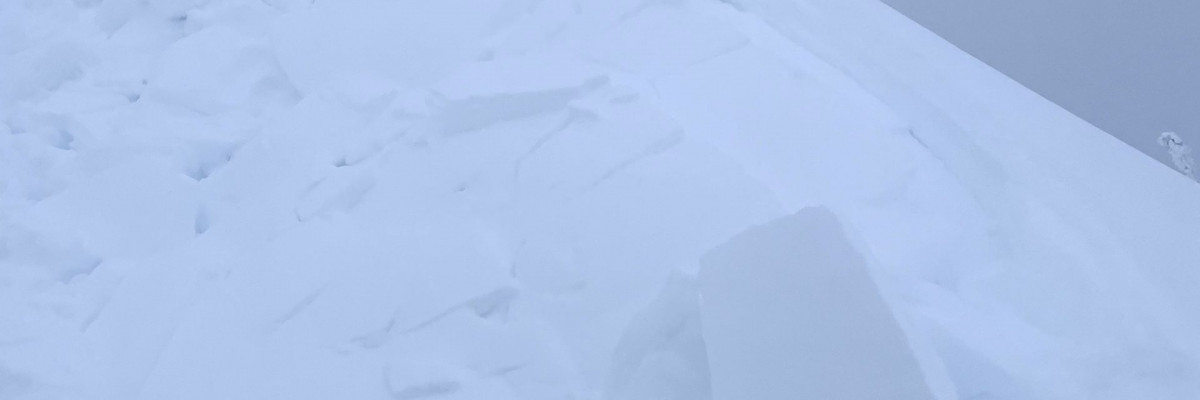The avalanche danger in the west central Montana backcountry is CONSIDERABLE.
Good Morning. This is Jeff Carty with the West Central Montana Avalanche Center advisory on Saturday, February 27, 2021. This advisory is sponsored by Spark R&D. This advisory does not apply to operating ski areas and expires at midnight tonight. The USDA Forest Service is solely responsible for its content.
Snowpack and Weather
Mountain temps are currently 10º to 22º F and will rise to the upper 20s today. The last 48hrs of weather brought us up to 1.2” of SWE and light to moderate winds. A few inches of snow is forecast today, with some areas picking up more or less due to local snow showers. Moderate winds are out of the west. Precipitation will continue till this evening.
The snow has continued to fall. Coupled with the wind it has created touchy wind slab conditions. A wind slab avalanche, with an 8-foot crown, released on the backside of Point 6 in the Rattlesnake Wilderness yesterday morning. This depth included wind loading from the storm earlier this week, indicating that wind slab created by Monday and Tuesday’s high winds are capable of failing with the current loading. Given the extent of loading on all aspects from the previous storm and subsequent snowfall, deep wind slab may be difficult to detect. The best way to manage this hazard is to avoid slopes over 32º and stay out from under steeper slopes, even small ones could harbor deep wind slab. Cornices are very touchy currently and could fall naturally. As wind and snow continue leeward slopes will be loaded further, increasing touchiness.
Persistent slabs are the problem that could create the most destructive avalanches. Multiple persistent weak layers exist in the snowpack, some up to 6 feet deep. These were propagating in tests yesterday and played a role in many of the avalanches over the past week. The January 13 rain crust/facet layer continues to be an issue in spots. Depth hoar and basal facets exist at mid-elevations and shallow spots in the southern and central Bitterroot and the Rattlesnake. Advanced facets on north aspects in the Rattlesnake are reactive. Buried surface hoar can be found in various locations. The snowpack has been loaded and is stressed. Loading will continue today. Persistent slabs can be unpredictable, especially as they get buried deeper. The R4 D4 slide in Lost Horse shows what these are capable of.
The continued snowfall is adding depth to the snowpack, which will help these persistent weak layers bond, and increase stability. Fair weather and warm temperatures next week will also help. In the short term, the loading is stressing the snowpack and weak layers. For the time being, give them space, avoid slopes over 32º, and enjoy the fresh powder.
The Bottom Line
Travel in avalanche terrain is not recommended. Careful terrain and snowpack assessment are required today. Avoid being under run-out zones, avalanches may be remotely triggered, and run to historic limits. You can trigger an avalanche remotely from the side, below, or above you. Expect the avalanche danger to be elevated as snow and winds continue.
Carry a beacon, shovel, and probe. Remember to reassess conditions throughout the day and stay alert for signs of instability. Dig a pit. Look for red flags.
Upcoming Education Events
Please visit our education page for an up-to-date list of regional educational events and course offerings. Below are a few select events and opportunities to check out.
-
- March 3rd, 6-7:30 PM MST | FREE Online 1.5-hr Avalanche Awareness Session | Missoulaavalanche.org event | Delivered by A3 Pro instructors | Get more details and register HERE
Special Announcements
You’ve prayed, hoped, and danced for snow all winter, and it’s finally here! Western Montana’s mountains are busier than ever before, with new and veteran backcountry users enjoying the fresh snow. To celebrate the snowfall and help ensure everyone has the information needed to enjoy the mountains and return home safely, we bring you Loving La Niña! This virtual fundraising event includes two outstanding gear packages and two ways to enter to win. Please click HERE for more information about this exciting event. Together, we can save lives and continue creating the most fun, safe, and responsible backcountry community possible. Spread the word, and spread the love for La Niña!
Public observations
We’ve been receiving excellent public observations. These are immensely helpful for us and a great resource for others to learn about conditions in specific locations. Keep them coming. Submit them here, or text to 406-219-5566 if you don’t have time to fill out the online form.
Ski and ride safe.
























